Case: we get off the needle of contextual advertising for free SEO traffic
This case can be divided into 2 parts. The first part is short - the essence of it. The second part - the details of the work. Who has experience in the field - can only get acquainted with the first part. Those who are interested in the details (someone will seem obvious and banal) - for you the second part.

We worked with a client for 45 000 p. per month. This amount consisted mainly of software website edits + SEO support (primary optimization, work on usability, news optimization and other minor improvements).
')
The budget was distributed as follows: 90% - site improvements, 10% - SEO. The theme is plastic windows, the Udmurt Republic region.
In parallel, another company was working on contextual advertising. This is how traffic is distributed.
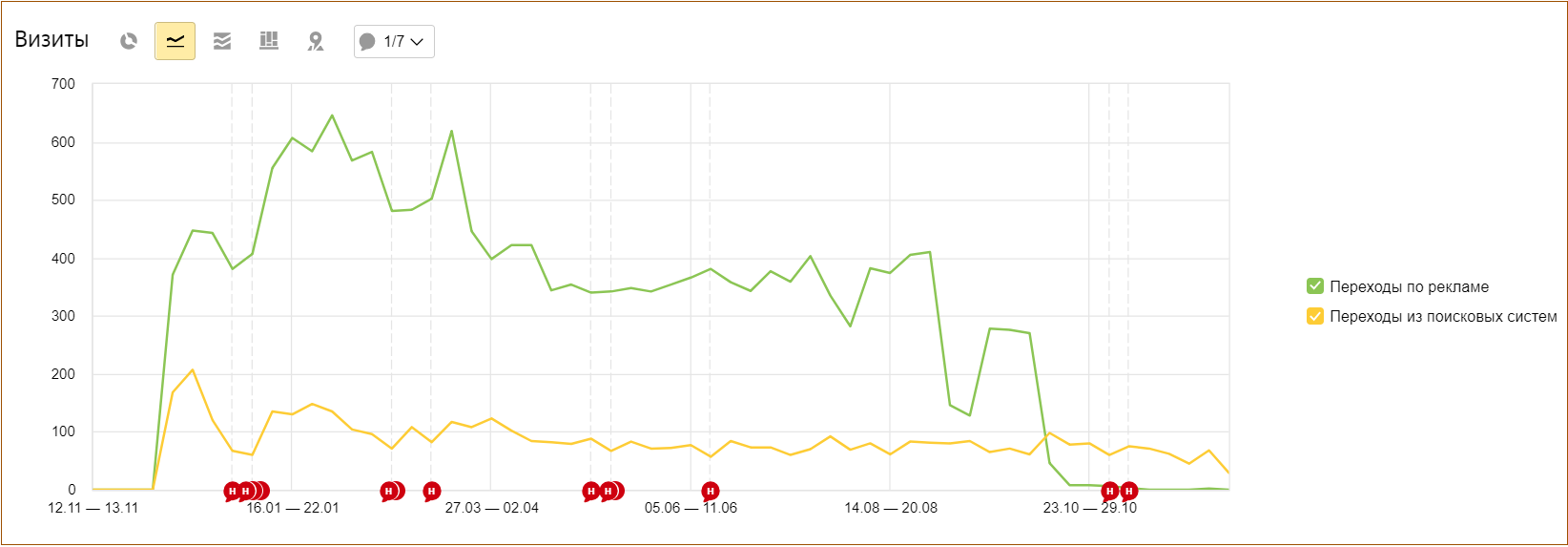
It should be borne in mind that part of the transitions from search engines is the same traffic from direct traffic, so there was less actual SEO traffic.
So we worked for a year. Engaged in edits, did little SEO optimization news and other materials.
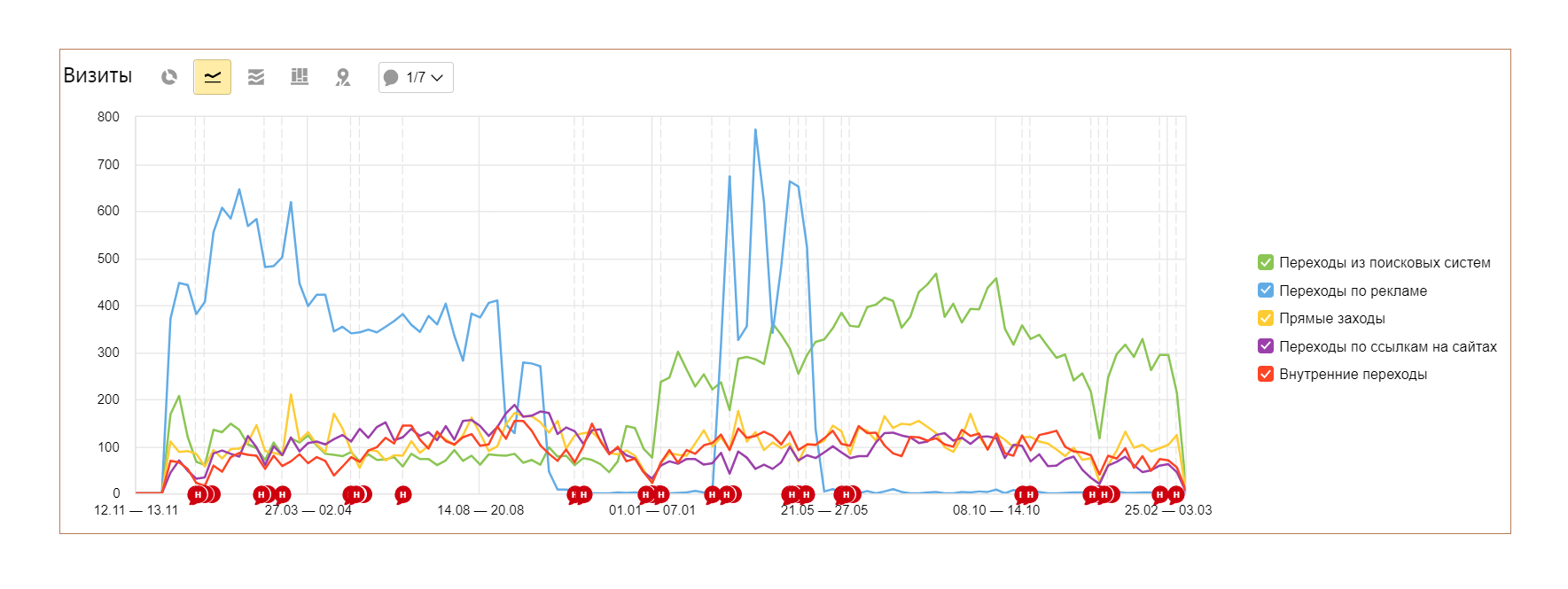
Contextual advertising has proven to be an extremely expensive tool. I don’t know budgets, but the company decided to stop working with directors and focus on SEO traffic.
What we have done as part of increasing traffic:
As a result, we received about the same 300-400 users per week and completely replaced contextual advertising, thus saving the client a decent amount.
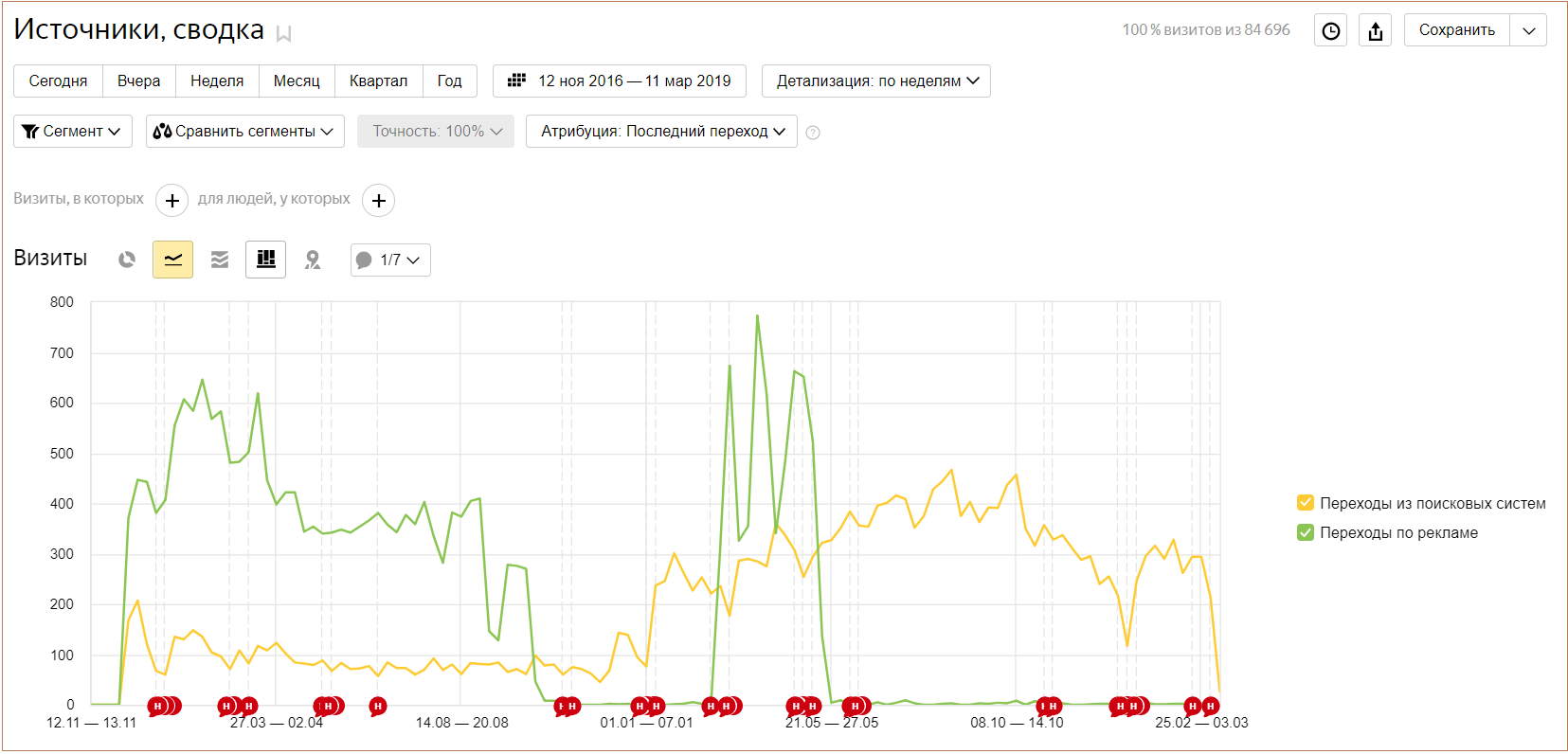
After a complete rejection of advertising, I saw a “breakdown” on the chart). Probably so simple advertising does not let go. This can be seen on the chart. After this outbreak, there was no relapse).

The situation at the start looked promising:
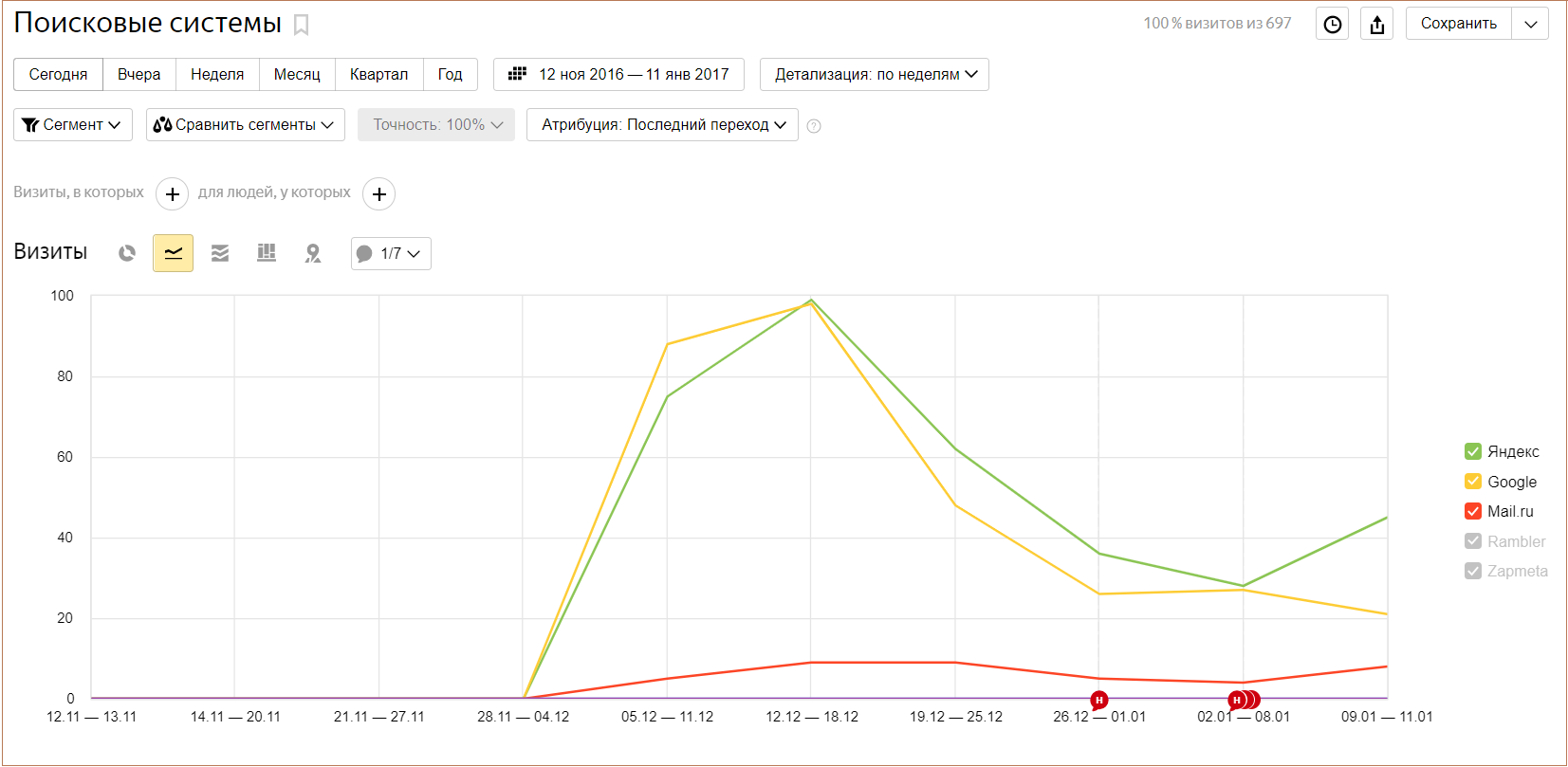
Almost immediately after indexing, traffic went to the site. Why?
The main reason - began to work actively advertising. Other reasons:
1. Good site structure. Products and services are divided into separate pages:
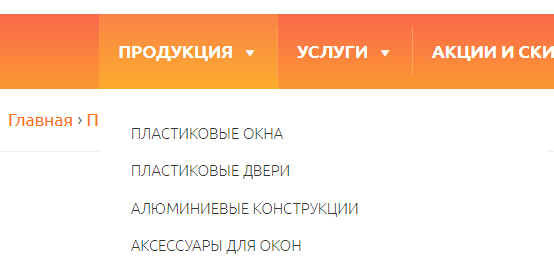
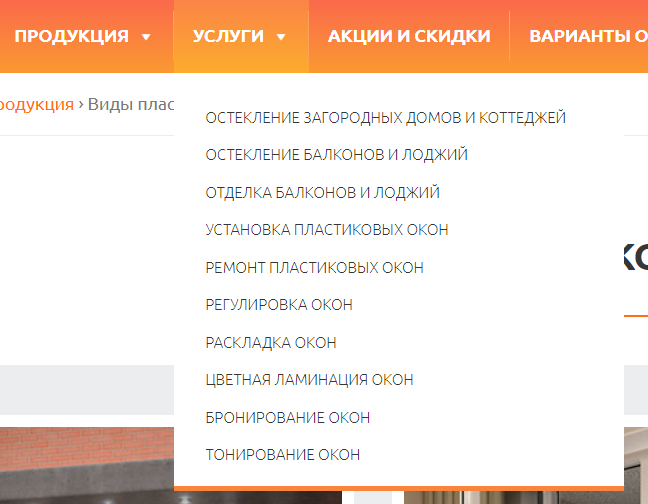
2. The presence of additional. functionality, calculators, visualization of windows, etc. In the subject it is probably not add. functional, and standard.

3. Clear, uncluttered design.
We will not go deep into the wilds of design. Everything is subjective.
4. Commercial factors
A) The ability to make an order / metering - a clear positioning as a commercial resource;
B) Cards of goods, a detailed description of all characteristics;
B) Discounts and promotions;
D) Availability prices. Not "from 10 000", not the button "Get a price", namely prices.

D) The presence of all certificates, details, any documents that can be shown. It is important to make a separate page for this.
E) Do not forget about the user agreement and personal data.
I) Examples of work (if any).
You can continue for a long time. I will give two actual sources, something like “Check-list”.
1) Link to an article with research from Ashmanov and partners - for more advanced. There is everything in detail
2) www.seonews.ru/analytics/predpoletnaya-podgotovka-chto-nuzhno-sdelat-s-internet-magazinom-do-nachala-seo-prodvizheniya - for the owners themselves. Perfect for setting targets for performers. The article is boring, but the information is relevant. I recommend to familiarize.
Next was the primary optimization. This is a preparation for promotion. Need absolutely all websites. Did all 20 working days.
You can do the initial optimization yourself, for this there is a mass of “Check-lists”. Google "SEO check list 2019". The optimization will take from 10 days of your time (provided that you do not know anything) to infinity. An average SEO specialist will do it in 1-2 weeks (depending on the site).
1. Get started on SEO before creating a website. Here is the procedure:
1) Semantic core (list of queries on your topic from wordstat.yandex.ru);
2) Site structure (using the x-mind program or analogues);
3) Design (for computers and mobile devices, which is obvious);
4) Layout (do not forget the micro-markup, read more here yandex.ru/support/webmaster/schema-org );
5) Primary optimization (what I wrote above);
6) Promotion (links, reviews, content).
2. There is a Yandex algorithm - a multi-armed gangster ( you can read here or just google), which temporarily throws your site in the TOP by high-frequency queries. If the bounce rate is low - the site remains in the TOP. The conclusion is obvious - we are trying to please users immediately.
3. The ideal link at the very beginning of work - SEO + context. In the first couple of ads gives a good impetus to behavioral factors, which is currently one of the most important metrics of search engines.
Recommendation to any business (especially a beginner) - make cases out of everything. They put a window - take pictures, sold the training - took feedback, etc.
In the first month on the site there were only 2-3 photos of finished works on the installation of windows / loggias / balconies.
Prepared content plan for the placement of works. Short:
Placed articles on landing pages (not all, but only on landing). With the texts do not pinch. They did not set strict TZ to copywriters, some did not even register the keys. We tried to do the most understandable to people. Our opinion - in this subject texts do not play a big role. Everyone understands what a plastic window is. 500-700 characters will be enough, we indicate the features of a particular model in them and how easier it is to purchase it.
Began to collect reviews. In our cases - all 100% real, with an indication of the contract:
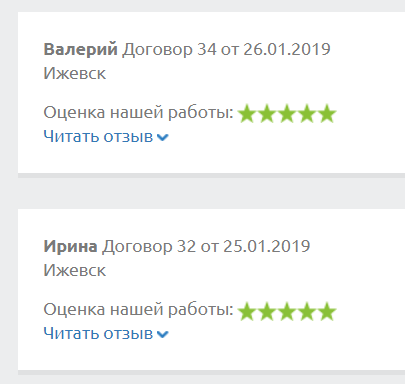
If you are just starting out, you can place fake ones. Only not 100 at once. And not necessarily positive. Dilute neutral. Negative is better not to post.
The site does not have a blog, but I would strongly recommend it to all business owners. The best content makes regular phone and photos + description of objects.
Unusual situations at the conclusion of contracts, oddities, pitfalls, pricing subtleties. All this makes your company alive. This is better than any congratulations on the New Year and other holidays (although this is good).
A few recommendations for a blog as an SEO tool:
Our task (if we are talking about SEO) is to increase the depth of viewing and the time spent on the site and reduce the bounce rate.
The depth of viewing in Yandex is the number of pages that a user has viewed during one visit to the site (https://yandex.ru/support/metrika/general/glossary.html)
The depth of viewing on Google is similar.
Google Bounce Rate - Google Analytics considers a failure to be a session in which only one request to the Google Analytics server was activated (for example, if a user opened one page of the site and left it without activating other requests). (https://support.google.com/analytics/answer/1009409?hl=en)
Refusal rate in Yandex - a visit is considered a failure if the following conditions are fulfilled simultaneously:
1) during the visit not more than one page view was recorded;
2) the duration of the visit is less than the time specified for the calculation of failures (by default, 15 seconds);
3) the non-repudiation service event was not recorded.
(https://yandex.ru/support/metrika/general/glossary.html)
In a simple way - if a person reads only thumbnails in your blog, and then closes the site - Google considers this as a refusal, and Yandex as a visit if it is on a page for more than 15 seconds.
We checked sites in Google-business and Yandex-directory (a small instruction on how to place it in this article vk.com/@nfdude-11-otvetov-pro-yandex-spravochnik ). Short:
1) Is the address correct?
2) Is there a logo;
3) Are all required fields filled?
4) Whether there are reviews.
Purchased links. Only about 40 pieces. How we buy links is written in the article (by the way, it can also be read on the official blog GGL - one of the reference exchanges ).
Each niche has its own forum / website / social network where a large number of audience is concentrated. Window niche is no exception.
www.oknamedia.ru is the largest portal where window companies are concentrated and reviews about them. From all over Russia. It would seem - write there fake reviews, get leads and everything in chocolate. But no.
However, we still used this portal as best we could. It was about 10 reviews per month. Used two services:
1. Workzilla.ru;
2. Advego.com.
Task setting is a separate topic for the article. This is a whole science that we still have to understand.
An SEO link is a link created to influence search algorithms. The ability to place SEO links on intermediary sites is often bought on special services - reference exchanges or aggregators. Therefore, they are often called “purchased” or “corrupt”.
SEO links are an attempt to deceive the search engine by artificially increasing the authority of the site. They do not improve the quality of the site and do not carry a positive signal for ranking. Therefore, Yandex considers SEO links search engine spam. (https://yandex.ru/support/webmaster/yandex-indexing/algorithm-minusinsk.html).
There was an unpleasant moment. The domain was with history (unfortunately, we did not check it).
You can check any service, for example, serpstat.com/ru or the same checktrust.
No filters were found, but there were a large number of junk links.
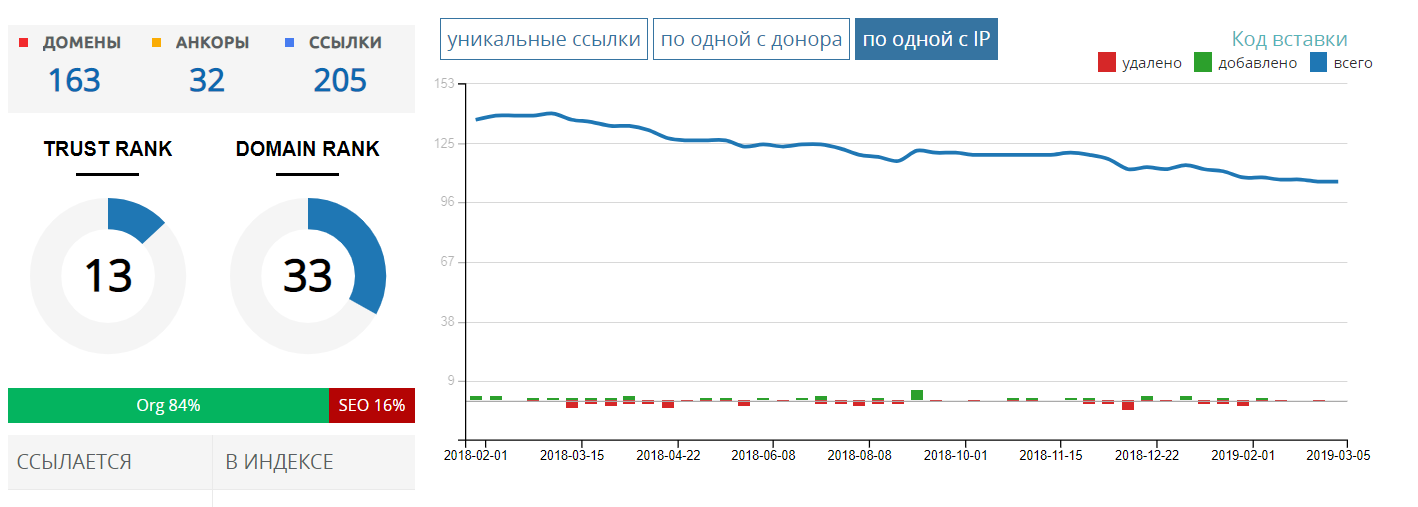
Trash link (our definition) is a link from poor quality in terms of design, usability, content and meaning in the whole resource. An example is www.krasland.ru/cat/?n=29160&kt=1 .
Often such sites are created specifically for the placement of rental links. Probably, the site had previously functioned, and then it was abandoned for several years. Perhaps, then these links were purchased.
Pros: the site has a reference weight, with an adequate anchor sheet (anchor - this is the text of the link). What is an adequate anchor list will be discussed in the following articles.
Cons: if it is cheap eternal links, they are extremely difficult to remove:
If these are rental links, things are even worse.
After the end of funds on the link exchange, the links become “Sleep”.
SLEEP - link is blocked due to zero optimizer balance. The link is not placed and does not occupy space.
Money for a link with this status is not credited. (https://help.sape.ru/sape/faq/36)
I had one old case on this topic (a conclusion from under Minusinsk), a screen from it:

This is the interface of the SAPE system. In this state, links can be found for months (I don’t know what rules SAPE has, I’m talking about what happened).
In a simple way - Yandex saw these links, but they were not. It's like a red rag for automatic pessimization algorithms.
So far, no sanctions have been found on the site, but we continue the search for access to the exchanges with a view to the subsequent removal of all this disgrace.
The article is not intended to diminish the effectiveness of contextual advertising, obviously - direct is not less effective tool if we talk about business in general.
I emphasize the importance of constantly searching for new, effective sales channels. Often I hear from friends and clients that contextual advertising works to zero or negative. Many survive only at the expense of high revolutions and afraid to slazit with "needle". Previously, a similar situation was with reference exchanges, such as SAPE. The client was moved to the site with rental links, and then he paid the subscription fee and support while being held captive by the system. Especially scary - when the site is the whole of your business asset.
In order not to get into this situation - continue to test new marketing tools, do not pour the whole budget in one direction. If the site is your store and source of income, lay a budget not only for advertising, but also for continuous improvement of usability, technical factors and external optimization.
I hope it was useful. Thank you for attention!

Stage 1 - we are satisfied with the context
We worked with a client for 45 000 p. per month. This amount consisted mainly of software website edits + SEO support (primary optimization, work on usability, news optimization and other minor improvements).
')
The budget was distributed as follows: 90% - site improvements, 10% - SEO. The theme is plastic windows, the Udmurt Republic region.
In parallel, another company was working on contextual advertising. This is how traffic is distributed.

It should be borne in mind that part of the transitions from search engines is the same traffic from direct traffic, so there was less actual SEO traffic.
So we worked for a year. Engaged in edits, did little SEO optimization news and other materials.

Stage 2 - go to organic traffic
Contextual advertising has proven to be an extremely expensive tool. I don’t know budgets, but the company decided to stop working with directors and focus on SEO traffic.
What we have done as part of increasing traffic:
- Once again, we reviewed the primary optimization, made some adjustments (obviously);
- You have done the linking (you can write a lot about linking types too, but honestly, it’s boring);
- Checked all the content for spam and uniqueness (obviously);
- Actively worked with crowd-links (important);
- Actively posted feedback on the work of the company (important);
As a result, we received about the same 300-400 users per week and completely replaced contextual advertising, thus saving the client a decent amount.

After a complete rejection of advertising, I saw a “breakdown” on the chart). Probably so simple advertising does not let go. This can be seen on the chart. After this outbreak, there was no relapse).

Stage 1 - usability + contextual advertising = behavioral factors
The situation at the start looked promising:

Almost immediately after indexing, traffic went to the site. Why?
The main reason - began to work actively advertising. Other reasons:
1. Good site structure. Products and services are divided into separate pages:


2. The presence of additional. functionality, calculators, visualization of windows, etc. In the subject it is probably not add. functional, and standard.

3. Clear, uncluttered design.
- Sans serif fonts, large readable size;
- Light background (background image);
- In 3 seconds you can understand what the company does and what can be done on the site (buy, calculate, call a measurer, call, etc.)
- Everything is made in the same color style.
We will not go deep into the wilds of design. Everything is subjective.
4. Commercial factors
A) The ability to make an order / metering - a clear positioning as a commercial resource;
B) Cards of goods, a detailed description of all characteristics;
B) Discounts and promotions;
D) Availability prices. Not "from 10 000", not the button "Get a price", namely prices.

D) The presence of all certificates, details, any documents that can be shown. It is important to make a separate page for this.
E) Do not forget about the user agreement and personal data.
I) Examples of work (if any).
You can continue for a long time. I will give two actual sources, something like “Check-list”.
1) Link to an article with research from Ashmanov and partners - for more advanced. There is everything in detail
2) www.seonews.ru/analytics/predpoletnaya-podgotovka-chto-nuzhno-sdelat-s-internet-magazinom-do-nachala-seo-prodvizheniya - for the owners themselves. Perfect for setting targets for performers. The article is boring, but the information is relevant. I recommend to familiarize.
Next was the primary optimization. This is a preparation for promotion. Need absolutely all websites. Did all 20 working days.
You can do the initial optimization yourself, for this there is a mass of “Check-lists”. Google "SEO check list 2019". The optimization will take from 10 days of your time (provided that you do not know anything) to infinity. An average SEO specialist will do it in 1-2 weeks (depending on the site).
Conclusions on the first stage
1. Get started on SEO before creating a website. Here is the procedure:
1) Semantic core (list of queries on your topic from wordstat.yandex.ru);
2) Site structure (using the x-mind program or analogues);
3) Design (for computers and mobile devices, which is obvious);
4) Layout (do not forget the micro-markup, read more here yandex.ru/support/webmaster/schema-org );
5) Primary optimization (what I wrote above);
6) Promotion (links, reviews, content).
2. There is a Yandex algorithm - a multi-armed gangster ( you can read here or just google), which temporarily throws your site in the TOP by high-frequency queries. If the bounce rate is low - the site remains in the TOP. The conclusion is obvious - we are trying to please users immediately.
3. The ideal link at the very beginning of work - SEO + context. In the first couple of ads gives a good impetus to behavioral factors, which is currently one of the most important metrics of search engines.
The second stage - content
Cases
Recommendation to any business (especially a beginner) - make cases out of everything. They put a window - take pictures, sold the training - took feedback, etc.
In the first month on the site there were only 2-3 photos of finished works on the installation of windows / loggias / balconies.
Prepared content plan for the placement of works. Short:
- Photos of real objects (because there was an opportunity)
- Collect reviews (real) in the appropriate section of the site;
- Several info-articles, texts on landing pages.
Texts
Placed articles on landing pages (not all, but only on landing). With the texts do not pinch. They did not set strict TZ to copywriters, some did not even register the keys. We tried to do the most understandable to people. Our opinion - in this subject texts do not play a big role. Everyone understands what a plastic window is. 500-700 characters will be enough, we indicate the features of a particular model in them and how easier it is to purchase it.
Reviews
Began to collect reviews. In our cases - all 100% real, with an indication of the contract:

If you are just starting out, you can place fake ones. Only not 100 at once. And not necessarily positive. Dilute neutral. Negative is better not to post.
Blog
The site does not have a blog, but I would strongly recommend it to all business owners. The best content makes regular phone and photos + description of objects.
Unusual situations at the conclusion of contracts, oddities, pitfalls, pricing subtleties. All this makes your company alive. This is better than any congratulations on the New Year and other holidays (although this is good).
A few recommendations for a blog as an SEO tool:
- Write in your own words, thematic jargon and specific words are also keys, which are often not used in the “official” texts on the landing pages, but people are looking for them;
- No need to bother with high-quality photos if it is labor-intensive. Photo on the phone;
- For the uniqueness of photos it is recommended to insert a neat watermark;
- Headline - 90% success. What is interesting to your audience? Banal example:
- Another glazing in an apartment building - wrong
- Double-glazed window No. 647: why lowered the price of installation - correctly
Our task (if we are talking about SEO) is to increase the depth of viewing and the time spent on the site and reduce the bounce rate.
The depth of viewing in Yandex is the number of pages that a user has viewed during one visit to the site (https://yandex.ru/support/metrika/general/glossary.html)
The depth of viewing on Google is similar.
Google Bounce Rate - Google Analytics considers a failure to be a session in which only one request to the Google Analytics server was activated (for example, if a user opened one page of the site and left it without activating other requests). (https://support.google.com/analytics/answer/1009409?hl=en)
Refusal rate in Yandex - a visit is considered a failure if the following conditions are fulfilled simultaneously:
1) during the visit not more than one page view was recorded;
2) the duration of the visit is less than the time specified for the calculation of failures (by default, 15 seconds);
3) the non-repudiation service event was not recorded.
(https://yandex.ru/support/metrika/general/glossary.html)
In a simple way - if a person reads only thumbnails in your blog, and then closes the site - Google considers this as a refusal, and Yandex as a visit if it is on a page for more than 15 seconds.
The third stage - external optimization
Yandex Reference and Google Business
We checked sites in Google-business and Yandex-directory (a small instruction on how to place it in this article vk.com/@nfdude-11-otvetov-pro-yandex-spravochnik ). Short:
1) Is the address correct?
2) Is there a logo;
3) Are all required fields filled?
4) Whether there are reviews.
Purchased links. Only about 40 pieces. How we buy links is written in the article (by the way, it can also be read on the official blog GGL - one of the reference exchanges ).
Crowd links
Each niche has its own forum / website / social network where a large number of audience is concentrated. Window niche is no exception.
www.oknamedia.ru is the largest portal where window companies are concentrated and reviews about them. From all over Russia. It would seem - write there fake reviews, get leads and everything in chocolate. But no.
- The service is closely connected with Yandex (honestly, I don’t know whether it belongs to them or simply cooperates), but sometimes clients wrote support from Yandex and scolded for posting “incorrect” reviews;
- Strict requirements for reviews . Contract number, city (calculated by IP!) And so on.
- Even with real reviews there are difficulties. From one account can not be posted.
However, we still used this portal as best we could. It was about 10 reviews per month. Used two services:
1. Workzilla.ru;
2. Advego.com.
Task setting is a separate topic for the article. This is a whole science that we still have to understand.
SEO links
An SEO link is a link created to influence search algorithms. The ability to place SEO links on intermediary sites is often bought on special services - reference exchanges or aggregators. Therefore, they are often called “purchased” or “corrupt”.
SEO links are an attempt to deceive the search engine by artificially increasing the authority of the site. They do not improve the quality of the site and do not carry a positive signal for ranking. Therefore, Yandex considers SEO links search engine spam. (https://yandex.ru/support/webmaster/yandex-indexing/algorithm-minusinsk.html).
There was an unpleasant moment. The domain was with history (unfortunately, we did not check it).
You can check any service, for example, serpstat.com/ru or the same checktrust.
No filters were found, but there were a large number of junk links.

Trash link (our definition) is a link from poor quality in terms of design, usability, content and meaning in the whole resource. An example is www.krasland.ru/cat/?n=29160&kt=1 .
Often such sites are created specifically for the placement of rental links. Probably, the site had previously functioned, and then it was abandoned for several years. Perhaps, then these links were purchased.
Pros: the site has a reference weight, with an adequate anchor sheet (anchor - this is the text of the link). What is an adequate anchor list will be discussed in the following articles.
Cons: if it is cheap eternal links, they are extremely difficult to remove:
- Site owners do not go to contact;
- If by some miracle you have found a webmaster, there is no guarantee that he will not ask for money for withdrawal (in 90% of cases he will ask);
- There is always the risk of a minusinsk filter .
If these are rental links, things are even worse.
After the end of funds on the link exchange, the links become “Sleep”.
SLEEP - link is blocked due to zero optimizer balance. The link is not placed and does not occupy space.
Money for a link with this status is not credited. (https://help.sape.ru/sape/faq/36)
I had one old case on this topic (a conclusion from under Minusinsk), a screen from it:

This is the interface of the SAPE system. In this state, links can be found for months (I don’t know what rules SAPE has, I’m talking about what happened).
In a simple way - Yandex saw these links, but they were not. It's like a red rag for automatic pessimization algorithms.
So far, no sanctions have been found on the site, but we continue the search for access to the exchanges with a view to the subsequent removal of all this disgrace.
findings
- SEO + context = perfect start;
- Other things being equal - the content decides;
- Check domain history;
- If the links are only eternal (or better, crowd);
- Analyze your traffic and expenses for it, choose the most profitable.
The article is not intended to diminish the effectiveness of contextual advertising, obviously - direct is not less effective tool if we talk about business in general.
I emphasize the importance of constantly searching for new, effective sales channels. Often I hear from friends and clients that contextual advertising works to zero or negative. Many survive only at the expense of high revolutions and afraid to slazit with "needle". Previously, a similar situation was with reference exchanges, such as SAPE. The client was moved to the site with rental links, and then he paid the subscription fee and support while being held captive by the system. Especially scary - when the site is the whole of your business asset.
In order not to get into this situation - continue to test new marketing tools, do not pour the whole budget in one direction. If the site is your store and source of income, lay a budget not only for advertising, but also for continuous improvement of usability, technical factors and external optimization.
I hope it was useful. Thank you for attention!
Source: https://habr.com/ru/post/446500/
All Articles